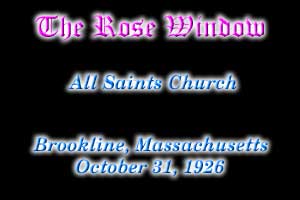
 |
|
This Rose, in unusually interesting stone tracery, supplies the artist in stained glass with patterns that are rich in suggestions for the peculiar possibilities of the craft. A stained glass window should always be a symbol, and this window arranges itself at once into one great symbol, enriched by many others through the varying bits of tracery, or "petals" of the "rose". The first impression of the window is one of glorious color, and the true reds and blues and whites are, themselves, symbols; red of Divine Love, blue of Divine Wisdom, and white of Purity and Serenity; while accents of green and gold are for Hope and Achievement. It is through the feeling associated with these colors rather than through any intellectual interpretation that one would feel the suggestion of the subject matter in color alone. The Glorification of Christ the Lord in Heaven and on Earth, especially by the saints of the earth, is made more definite by the actual design. It is most eloquent in the central Figure of Christ seated on a throne in the attitude of invitation and blessing. This figure is, in itself, the supreme symbol of the grace and power of Christianity. On either side are the first and last letters of the Greek alphabet: symbols of Christ, "The First and the Last". Around the circle are the words: "Alleluia, Salvation and Glory and Honor and Power unto the Lord Our God, Alleluia", from the Revelation of Saint John the Evangelist. In the tracery pieces surrounding the central circle are twelve outflying doves with haloes, symbols of the Twelve Gifts of the Holy Ghost - Charity, Joy, Peace, Patience, Benignity, Goodness, Longanimity, Mildness, Faith, Modesty, Continency, and Chastity. With the doves are six seraphim, symbols of the six days of Creation, and, therefore, of the Coming of Christ since the beginning of Time. In the twelve longer tapering sections are cherubim, which are for the Wisdom of God, as the seraphim are for the Love of God, representing the Twelve Prophets and the Twelve Disciples. This symbolism is mademore direct by the use in the central motive of the Hebraic Stars for the Twelve Minor Prophets, and the flames for the Twelve Apostles. This same idea is continued afresh in the use of figures in the six shapes resembling quatrefoils in the outer edge of the rose. The two most distinguished figures are those of Saint Peter in the upper tracery piece, and Saint Paul in the lower. Both saints are supported by angels with censers, symbols of Prayer and Praise, and by their best known heraldic symbols: Saint Peter by the key and book and cock, and Saint Paul by the book and sword and the three fountains. The symbolism of Prayer and Praise is made more eloquent by the larger angels that occur in the triangular pieces at the edge of the rose. The Followers of Christ and the Upbuilders of His Kingdom are further symbolized by the figures of the Four Major Prophets, the Four Latin Fathers, and the Four Evangelists that continue through the four quatrefoil-like shapes on the left and right sides of the rose. The Four Major Prophets carry scrolls on which are inscribed their names, "Isaiah, Jeremiah, Ezekiel, and Daniel". The Four Latin Fathers are robed as Bishops, and wear the Bishop's mitre, with the exception of Saint Jerome, who wears the Cardinal's hat. They are, on the left, Saint Jerome and Saint Gregory, with the dove and the book; on the right Saint Ambrose, with the scourge, and Saint Augustine, with the book inscribed with the heart and crossed arrows. The Evangelists occur, on the left, Saint Matthew, with his symbol the Angel; on the right, Saint Mark, with his symbol the Lion; on the left, Saint Luke, with the Ox; and on the right, Saint John, with the Eagle. The Sun and the Moon occur in the lower trifoil pieces, and throughout the composition are conventionalized clouds, time-honored symbols of the Heavenly Kingdom. While
this elaborate and carefully studied symbolism will reward the
inquirer, and will appear from time to time to all who see the
window Sunday after Sunday, its great mission is in the realm
of the emotions, and it should sing in the brilliant light of
day like a great toned organ, keyed to sight rather than to sound.
It should suggest in its harmonies the words of the psalmist:
"Praise ye the Lord, for He is Good. His Mercy endureth
forever".
|
|||
|
DESIGNER: Charles J. Connick ARCHITECT: Cram and Ferguson DEDICATED: October 31, 1926 DONOR: Edward D. Ver Planck
HEIGHT FROM FLOOR: 24'6" VENTILATORS: None PRICE: $7500
|
|||||
|
|
|
|
|
|
|
|
|
|
|
|
|
|
|
| PROPHET:
Ezekiel LATIN FATHER: Saint Augustine (with Book) EVANGELIST: Saint John (with Eagle) |
PROPHET:
Daniel LATIN FATHER: Saint Ambrose (with Scourge) EVANGELIST: Saint Mark (with the Lion) |
 |
 |